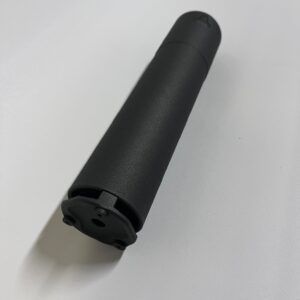Ultra light and durable, with a smooth low snag design. They don't catch on brush, clothing or barricades. Designed for dedicated use on bolt action hunting rifles, PRS rifles, or that old truck gun
-

Sasquatch
Price range: $949.00 through $999.00 Select options This product has multiple variants. The options may be chosen on the product page -

Snipe Hunter
$375.00 Add to cart -

YeTi
Price range: $1,049.00 through $1,099.00 Select options This product has multiple variants. The options may be chosen on the product page
Frequently Asked Questions
Why direct thread?
Maximum accuracy comes from the fewest variations in your shooting platform. This is best achieved by indexing your suppressor directly to the shoulder of the threaded barrel with the same torque every time. Each thread or joint that is added with other attachment types introduces the potential for increased runout, unpredictable barrel harmonics, interference from carbon/dirt, and more.
For most semi-automatic rifles and even many shorter range bolt rifles this may not be an issue. If, on the other hand you are shooting at extended ranges while hunting or at steel plates/paper, you need confidence that you have the most solid platform possible.
What will happen to my rifle's accuracy?
Short answer: most of the time, you will get a point of impact (POI) shift but the group size will typically stay similar to groups shot without. For best results, a rifle will be tuned and zeroed WITH the suppressor attached, and removed as little as possible.
With new or young shooters, group size is almost always better due to lower recoil combined with near zero muzzle blast. Decreased flinch, increased shooter comfort and confidence are the most important aspects of shooting accurately.
Short, heavy barrels like those on a Rem 700 SPS-T (heavy 16") will generally be less affected than long skinny barrels like a 26" ultra lite Kimber. But of course this isnt always true; in the case of these two example rifles, a Kimber we tested with a very skinny barrel had essentially zero POI shift and no change in group size. Meanwhile a SPS-T test gun has a very consistent .5" POI shift up and to the right, but group size does not change.
Are they a serviceable design?
The Snipe Hunter is a take-down type that can be disassembled and cleaned due to the very dirty nature of rimfire ammunition.
In order to make these as light and strong as possible, all centerfire models are a one-piece design that cannot be disassembled. Centerfire suppressors generally do not need cleaning, especially when used with higher power rifle cartridges.
How do I clean a centerfire suppressor if I really want to?
With each suppressor a rubber plug is included to plug the endcap. Just fill with BoreTech C4 and let sit for a day. Then plug the threaded side with your thumb and shake vigorously before pouring the contents out of the threaded end. Firing a couple shots through and redoing this process can help guarantee as much carbon as possible is jarred loose and cleaned from the baffles.
Other products like CLR may work as well or better, but many can cause problems with the Cerakote finish.
Are these "Full Auto Rated"
No. Do you hunt and long range compete with a machine gun? Probably not, but it does sound pretty fun.
In order to get the lightest and quietest performance, we machine Grade 5 titanium (6Al-4V) to very strict tolerances. Grade 5 Ti is a fantastic material for suppressors due to very low thermal conductivity combined with a very high strength to weight ratio. But for very rapid and extended or full auto fire rates, other heavier materials are better suited.
For the type of rifle system that these are designed for, other issues such as throat erosion, copper/carbon fouling and stress cracking in the barrel are usually the most important to the shooter.
How are they built?
After the CNC machining is finished for all the parts of each suppressor, a series of processes including tumbling, rinsing, and degreasing are done right before hand assembly. After assembly, it is placed in a custom CNC laser welder. Each weld is fully circumferential with the start/stop points as well as the weld sequence offset in a fashion that helps minimize runout from heat distortion.
Once welded, they are all tested with custom gauges to ensure concentricity and then laser engraved. At this point we shoot each one at 100 yards using a proven test rifle that was zeroed with a reference suppressor of the same model. This helps ensure consistency between every batch of suppressors and guarantees safe function.
After all of this, they are cleaned, oxide blasted, and finally Cerakoted.